The first Japanese immigrants arrived in Brazil in 1908. Brazil is home to the largest Japanese population outside Japan.According to the IBGE, as of 2009 there were approximately 1.6 million people of Japanese descent in Brazil and estimated at just under 1.5 million as of 2014.Since the 1980s, a return migration has emerged of Japanese Brazilians to Japan. More recently, a trend of interracial marriage has taken hold among Brazilians of Japanese descent, with the racial intermarriage rate approximated at 50% and increasing.
Background
Between the end of the 19th and early 20th centuries, coffee was the main export product of Brazil. At first, Brazilian farmers used African slave labour in the coffee plantations, but in 1850, the slave trade was abolished in Brazil. To solve the labour shortage, the Brazilian elite decided to attract European immigrants to work on the coffee plantations. This also was in line the government's push towards "whitening" the country. The hope was that through procreation the large African and Native American groups would be eliminated or reduced.The government and farmers offered to pay European immigrants' passage. The plan encouraged millions of Europeans, most of them Italians,to migrate to Brazil. However, once in Brazil, the immigrants received very low salaries and worked in poor conditions, including long working hours and frequent ill-treatment by their bosses. Because of this, in 1902, Italy enacted Decree Prinetti, prohibiting subsidized immigration to Brazil.
The end of feudalism in Japan generated great poverty in the rural population, so many Japanese began to emigrate in search of better living conditions. By the 1930s, Japanese industrialisation had significantly boosted the population. However, prospects for Japanese people to migrate to other countries were limited. The US had banned non-white immigration from some parts of the world on the basis that they would not integrate into society; this Exclusion Clause, of the 1924 Immigration Act, specifically targeted the Japanese. At the same time in Australia, the White Australia Policy prevented the immigration of non-whites to Australia.
First immigrants
In 1907, the Brazilian and the Japanese governments signed a treaty permitting Japanese migration to Brazil. This was due in part to the decrease in the Italian immigration to Brazil and a new labour shortage on the coffee plantations.Also, Japanese immigration to the United States had been barred by the Gentlemen's Agreement of 1907. The first Japanese immigrants (790 people – mostly farmers) came to Brazil in 1908 on the Kasato Maru. About half of these immigrants came from southern Okinawa.They travelled from the Japanese port of Kobe via the Cape of Good Hope in South Africa. Many of them became owners of coffee plantations.
In the first seven years, 3,434 more Japanese families (14,983 people) arrived. The beginning of World War I in 1914 started a boom in Japanese migration to Brazil; such that between 1917 and 1940 over 164,000 Japanese came to Brazil, 75% of them going to São Paulo, where most of the coffee plantations were located.
New life in Brazil
The vast majority of Japanese immigrants intended to work a few years in Brazil, make some money, and go home. However, "getting rich quick" was a dream that was almost impossible to achieve. The immigrants were paid a very low salary and worked long hours of exhausting work. Also, everything that the immigrants consumed had to be purchased from the landowner (see truck system). Soon, their debts became very significant.
The land owners in Brazil still had a slavery mentality. Immigrants, although employees, had to confront the rigidity and lack of labour laws. Indebted and subjected to hours of exhaustive work, often suffering physical violence, the immigrants saw the leak as an alternative to escape the situation. Suicide, yonige (to escape at night), and strikes were some of the attitudes taken by many Japanese because of the exploitation on coffee farms.
The barrier of language, religion, dietary habits, clothing, lifestyles and differences in climate entailed a culture shock. Many immigrants tried to return to Japan but were prevented by Brazilian farmers, who required them to comply with the contract and work with the coffee.
On 1 August 1908, The New York Times remarked that relations between Brazil and Japan at the time were "not extremely cordial", because of "the attitude of Brazil toward the immigration of Japanese labourers."
Japanese children born in Brazil were educated in schools founded by the Japanese community. Most only learned to speak the Japanese language and lived within the Japanese community in rural areas. Over the years, many Japanese managed to buy their own land and became small farmers. They started to plant strawberries, tea and rice. Only 6% of children were the result of interracial relationships. Immigrants rarely accepted marriage with a non-Japanese person
Prejudice and forced assimilation
On 28 July 1921, representatives Andrade Bezerra and Cincinato Braga proposed a law whose Article 1 provided: "The immigration of individuals from the black race to Brazil is prohibited." On 22 October 1923, representative Fidélis Reis produced another bill on the entry of immigrants, whose fifth article was as follows: "The entry of settlers from the black race into Brazil is prohibited. For Asian [immigrants] there will be allowed each year a number equal to 5% of those residing in the country. . . ."
Some years before World War II, the government of President Getúlio Vargas initiated a process of forced assimilation of people of immigrant origin in Brazil. The Constitution of 1934 had a legal provision about the subject: "The concentration of immigrants anywhere in the country is prohibited, the law should govern the selection, location and assimilation of the alien". The assimilationist project affected mainly Japanese, Italian, Jewish, and German immigrants and their descendants.
In the government's conception, the non-White population of Brazil should disappear within the dominant class of Portuguese Brazilian origin.This way, the mixed-race population should be "whitened" through selective mixing, then a preference for European immigration. In consequence, the non-white population would, gradually, achieve a desirable White phenotype. The government focused on Italians, Jews, and Japanese.The formation of "ethnic cysts" among immigrants of non-Portuguese origin prevented the realization of the whitening project of the Brazilian population. The government, then, started to act on these communities of foreign origin to force them to integrate into a "Brazilian culture" with Portuguese roots. It was the dominant idea of a unification of all the inhabitants of Brazil under a single "national spirit". During World War II, Brazil severed relations with Japan. Japanese newspapers and teaching the Japanese language in schools were banned, leaving Portuguese as the only option for Japanese descendants. Newspapers in Italian or German were also advised to cease production, as Italy and Germany were Japan's allies in the war.In 1939, research of Estrada de Ferro Noroeste do Brasil, from São Paulo, showed that 87.7% of Japanese Brazilians read newspapers in the Japanese language, a high figure for a country with many illiterate people like Brazil at the time.
The Japanese appeared as undesirable immigrants within the "whitening" and assimilationist policy of the Brazilian government.Oliveira Viana, a Brazilian jurist, historian and sociologist described the Japanese immigrants as follows: "They (Japanese) are like sulfur: insoluble". The Brazilian magazine "O Malho" in its edition of 5 December 1908 issued a charge of Japanese immigrants with the following legend: "The government of São Paulo is stubborn. After the failure of the first Japanese immigration, it contracted 3,000 yellow people. It insists on giving Brazil a race diametrically opposite to ours".In 1941, the Brazilian Minister of Justice, Francisco Campos, defended the ban on admission of 400 Japanese immigrants in São Paulo and wrote: "their despicable standard of living is a brutal competition with the country’s worker; their selfishness, their bad faith, their refractory character, make them a huge ethnic and cultural cyst located in the richest regions of Brazil".
The Japanese Brazilian community was strongly marked by restrictive measures when Brazil declared war against Japan in August 1942. Japanese Brazilians could not travel the country without safe conduct issued by the police; over 200 Japanese schools were closed and radio equipment was seized to prevent transmissions on short wave from Japan. The goods of Japanese companies were confiscated and several companies of Japanese origin had interventions, including the newly founded Banco América do Sul. Japanese Brazilians were prohibited from driving motor vehicles (even if they were taxi drivers), buses or trucks on their property. The drivers employed by Japanese had to have permission from the police. Thousands of Japanese immigrants were arrested or expelled from Brazil on suspicion of espionage. There were many anonymous denunciations of "activities against national security" arising from disagreements between neighbours, recovery of debts and even fights between children .Japanese Brazilians were arrested for "suspicious activity" when they were in artistic meetings or picnics. On 10 July 1943, approximately 10,000 Japanese and German and Italian immigrants who lived in Santos had 24 hours to close their homes and businesses and move away from the Brazilian coast. The police acted without any notice. About 90% of people displaced were Japanese. To reside in Baixada Santista, the Japanese had to have a safe conduct. In 1942, the Japanese community who introduced the cultivation of pepper in Tomé-Açu, in Pará, was virtually turned into a "concentration camp". This time, the Brazilian ambassador in Washington, D.C., Carlos Martins Pereira e Sousa, encouraged the government of Brazil to transfer all the Japanese Brazilians to "internment camps" without the need for legal support, in the same manner as was done with the Japanese residents in the United States. No single suspicion of activities of Japanese against "national security" was confirmed.
During the National Constituent Assembly of 1946, Rio Miguel Couto Filho proposed Amendments to the Constitution as follows: "It is prohibited the entry of Japanese immigrants of any age and any origin in the country". In the final vote, a tie with 99 votes in favour and 99 against. Senator Fernando de Melo Viana, who chaired the session of the Constituent Assembly, had the casting vote and rejected the constitutional amendment. By only one vote, the immigration of Japanese people to Brazil was not prohibited by the Brazilian Constitution of 1946.
The Japanese immigrants appeared to the Brazilian government as undesirable and non-assimilable immigrants. As Asian, they did not contribute to the "whitening" process of the Brazilian people as desired by the ruling Brazilian elite. In this process of forced assimilation the Japanese, more than any other immigrant group, suffered the ethno-cultural persecution imposed during this period.
Prestige
For decades, Japanese Brazilians were seen as a non-assimilable people. The immigrants were treated only as a reserve of cheap labour that should be used on coffee plantations and that Brazil should avoid absorbing their cultural influences. This widespread conception that the Japanese were negative for Brazil was changed in the following decades. The Japanese were able to overcome the difficulties along the years and drastically improve their lives through hard work and education; this was also facilitated by the involvement of the Japanese government in the process of migration. The image of hard working agriculturists that came to help develop the country and agriculture helped erase the lack of trust of the local population and create a positive image of the Japanese. In the 1970s, Japan became one of the richest countries of the world, synonymous with modernity and progress. In the same period, Japanese Brazilians achieved a great cultural and economic success, probably the immigrant group that most rapidly achieved progress in Brazil. Due to the powerful Japanese economy and due to the rapid enrichment of the Nisei, in the last decades Brazilians of Japanese descent achieved a social prestige in Brazil that largely contrasts with the aggression with which the early immigrants were treated in the country.
Integration and intermarriage
As of 2008, many Japanese Brazilians belong to the third generation (sansei), who make up 41.33% of the community. First generation (issei) are 12.51%, second generation (nisei) are 30.85% and fourth generation (yonsei) 12.95%.
A more recent phenomenon in Brazil is intermarriages between Japanese Brazilians and non-ethnic Japanese. Though people of Japanese descent make up only 0.8% of the country's population, they are the largest Japanese community outside Japan, with over 1.4 million people. In areas with large numbers of Japanese, such as São Paulo and Paraná, since the 1970s, large numbers of Japanese descendants started to marry into other ethnic groups. Jeffrey Lesser's work has shown the complexities of integration both during the Vargas era, and more recently during the dictatorship (1964–1984)
Nowadays, among the 1.4 million Brazilians of Japanese descent, 28% have some non-Japanese ancestry.[29] This number reaches only 6% among children of Japanese immigrants, but 61% among great-grandchildren of Japanese immigrants.
Religion
Immigrants, as well as most Japanese, were mostly followers of Shinto and Buddhism. In the Japanese communities in Brazil, there was a strong effort by Brazilian priests to proselytize the Japanese. More recently, intermarriage with Catholics also contributed to the growth of Catholicism in the community. Currently, 60% of Japanese-Brazilians are Roman Catholics and 25% are adherents of a Japanese religion.
Martial arts
The Japanese immigration to Brazil, in particular the immigration of the judoka Mitsuyo Maeda, resulted in the development of one of the most effective modern martial arts, Brazilian Jiu-Jitsu.
Language
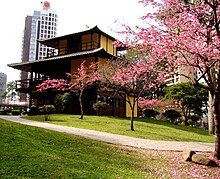
Cherry blossom in Japan's Square in Curitiba, Paraná.
The knowledge of the Japanese and Portuguese languages reflects the integration of the Japanese in Brazil over several generations. Although first generation immigrants will often not learn Portuguese well or not use it frequently, most second generation are bilingual. The third generation, however, are most likely monolingual in Portuguese or speak, along with Portuguese, non-fluent Japanese.
A study conducted in the Japanese Brazilian communities of Aliança and Fukuhaku, both in the state of São Paulo, released information on the language spoken by these people. Before coming to Brazil, 12.2% of the first generation interviewed from Aliança reported they had studied the Portuguese language in Japan, and 26.8% said to have used it once on arrival in Brazil. Many of the Japanese immigrants took classes of Portuguese and learned about the history of Brazil before migrating to the country. In Fukuhaku only 7.7% of the people reported they had studied Portuguese in Japan, but 38.5% said they had contact with Portuguese once on arrival in Brazil. All the immigrants reported they spoke exclusively Japanese at home in the first years in Brazil. However, in 2003, the figure dropped to 58.5% in Aliança and 33.3% in Fukuhaku. This probably reflects that through contact with the younger generations of the family, who speak mostly Portuguese, many immigrants also began to speak Portuguese at home.
The first Brazilian-born generation, the Nisei, alternate between the use of Portuguese and Japanese. Regarding the use of Japanese at home, 64.3% of Nisei informants from Aliança and 41.5% from Fukuhaku used Japanese when they were children. In comparison, only 14.3% of the third generation, Sansei, reported to speak Japanese at home when they were children. It reflects that the second generation was mostly educated by their Japanese parents using the Japanese language. On the other hand, the third generation did not have much contact with their grandparent's language, and most of them speak the national language of Brazil, Portuguese, as their mother tongue.
Japanese Brazilians usually speak Japanese more often when they live along with a first generation relative. Those who do not live with a Japanese-born relative usually speak Portuguese more often.Japanese spoken in Brazil is usually a mix of different Japanese dialects, since the Japanese community in Brazil came from all regions of Japan, influenced by the Portuguese language. The high numbers of Brazilian immigrants returning from Japan will probably produce more Japanese speakers in Brazil.
Distribution and population
According to the IBGE, as of 2000 there were 70,932 Japanese-born immigrants living in Brazil (compared to the 158,087 found in 1970). Of the Japanese, 51,445 lived in São Paulo. Most of the immigrants were over 60 years old, because the Japanese immigration to Brazil has ended since the mid-20th century.
In 2008, IBGE published a book about the Japanese diaspora and it estimated that, as of 2000, there were 1,405,685 people of Japanese descent in Brazil. The Japanese immigration was concentrated to São Paulo and, still in 2000, 49.3% of Japanese Brazilians lived in this state. There were 693,495 people of Japanese origin in São Paulo, followed by Paraná with 143,588. More recently, Brazilians of Japanese descent are making presence in places that used to have a small population of this group. For example: in 1960, there were 532 Japanese Brazilians in Bahia, while in 2000 they were 78,449, or 0.6% of the state's population. Northern Brazil (excluding Pará) saw its Japanese population increase from 2,341 in 1960 (0.2% of the total population) to 54,161 (0.8%) in 2000. During the same period, in Central-Western Brazil they increased from 3,582 to 66,119 (0.7% of the population).[3] However, the overall Japanese population in Brazil is shrinking, secondary to a decreased birth rate and an aging population; return immigration to Japan,[as well as intermarriage with other races and dilution of ethnic identity.
For the whole Brazil, with over 1.4 million people of Japanese descent, the largest percentages were found in the states of São Paulo (1.9% of Japanese descent), Paraná (1.5%) and Mato Grosso do Sul (1.4%). The smallest percentages were found in Roraima and Alagoas (with only 8 Japanese). The percentage of Brazilians with Japanese roots largely increased among children and teenagers. In 1991, 0.6% of Brazilians between 0 and 14 years old were of Japanese descent. In 2000, they were 4%, as a result of the returning of Dekasegis (Brazilians of Japanese descent who work in Japan) to Brazil.
Image gallery
Japanese from Maringá
A 2008 census revealed details about the population of Japanese origin from the city of Maringá in Paraná, making it possible to have a profile of the Japanese-Brazilian population.
- Numbers
There were 4,034 families of Japanese descent from Maringá, comprising 14,324 people.
- Dekasegi
1,846 or 15% of Japanese Brazilians from Maringá were working in Japan.
- Generations
Of the 12,478 people of Japanese origin living in Maringá, 6.61% were Issei (born in Japan); 35.45% were Nisei (children of Japanese); 37.72% were Sansei (grandchildren) and 13.79% were Yonsei (great-grandchildren).
- Average age
The average age was of 40.12 years old
- Gender
52% of Japanese Brazilians from the city were women.
- Average number of children per woman
2.4 children (similar to the average Southern Brazilian woman)
- Religion
Most were Roman Catholics (32% of Sansei, 27% of Nisei, 10% of Yonsei and 2% of Issei). Protestant religions were the second most followed (6% of Nisei, 6% of Sansei, 2% of Yonsei and 1% of Issei) and next was Buddhism (5% of Nisei, 3% of Issei, 2% of Sansei and 1% of Yonsei).
- Family
49.66% were married.
- Knowledge of the Japanese language
47% can understand, read and write in Japanese. 31% of the second generation and 16% of the third generation can speak Japanese.
- Schooling
31% elementary education; 30% secondary school and 30% higher education.
- Mixed-race
20% were mixed-race (have some non-Japanese origin).
The Dekasegi
In 1990, the Japanese government authorized the legal entry of Japanese and their descendants until the third generation in Japan. At that time, Japan was receiving a large number of illegal immigrants from Pakistan, Bangladesh, China, and Thailand. The legislation of 1990 was intended to select immigrants who entered Japan, giving a clear preference for Japanese descendants from South America, especially Brazil. These people were lured to Japan to work in areas that the Japanese refused (the so-called "three K": Kitsui, Kitanai and Kiken – hard, dirty and dangerous). Many Japanese Brazilians began to immigrate. The influx of Japanese descendants from Brazil to Japan was and continues to be large: there are over 300,000 Brazilians living in Japan today, mainly as workers in factories.
Because of their Japanese ancestry, the Japanese Government believed that Brazilians would be more easily integrated into Japanese society. In fact, this easy integration did not happen, since Japanese Brazilians and their children born in Japan are treated as foreigners by native Japanese.This apparent contradiction between being and seeming causes conflicts of adaptation for the migrants and their acceptance by the natives.
They also constitute the largest number of Portuguese speakers in Asia, greater than those of formerly Portuguese East Timor, Macau and Goa combined. Likewise, Brazil, alongside the Japanese American population of the United States, maintains its status as home to the largest Japanese community outside Japan.
Cities and prefectures with the most Brazilians in Japan are: Hamamatsu, Aichi, Shizuoka, Kanagawa, Saitama, and Gunma. Brazilians in Japan are usually educated. However, they are employed in the Japanese automotive and electronics factories.[45] Most Brazilians go to Japan attracted by the recruiting agencies (legal or illegal) in conjunction with the factories. Many Brazilians are subjected to hours of exhausting work, earning a small salary by Japanese standards.Nevertheless, in 2002, Brazilians living in Japan sent US$2.5 billion to Brazil.
Due to the financial crisis of 2007–2010, many Brazilians returned from Japan to Brazil. From January 2011 to March, it is estimated that 20,000 Brazilian immigrants left Japan.[48]
Brazilian identity in Japan
In Japan, many Japanese Brazilians suffer prejudice because they do not know how to speak Japanese fluently. Despite their Japanese appearance, Brazilians in Japan are culturally Brazilians, usually only speaking Portuguese, and are treated as foreigners.
The children of Dekasegi Brazilians encounter difficulties in Japanese schools.[50] Thousands of Brazilian children are out of school in Japan.
Academic studies report that many Japanese Brazilians felt (and were often treated) as Japanese in Brazil. But when they move to Japan, they realize that they strongly feel their Brazilian background. In Brazil, Japanese Brazilians rarely listened to samba or participated in a carnival parade. However, once in Japan, Japanese Brazilians often promote carnivals and samba festivities in the Japanese cities to demonstrate their pride of being Brazilian.[51][failed verification]
The Brazilian influence in Japan is growing. Tokyo has the largest carnival parade outside of Brazil itself. Portuguese is the third most spoken foreign language in Japan, after Chinese and Korean, and is among the most studied languages by students in the country. In Oizumi, it is estimated that 15% of the population speak Portuguese as their native language. Japan has two newspapers in the Portuguese language, besides radio and television stations spoken in that language. The Brazilian fashion and Bossa Nova music are also popular among Japanese.In 2005, there were an estimated 302,000 Brazilian nationals in Japan, of whom 25,000 also hold Japanese citizenship.
100th anniversary
In 2008, many celebrations took place in Japan and Brazil to remember the centenary of Japanese immigration Prince Naruhito of Japan arrived in Brazil on 17 June to participate in the celebrations. He visited Brasília, São Paulo, Paraná, Minas Gerais and Rio de Janeiro. Throughout his stay in Brazil, the Prince was received by a crowd of Japanese immigrants and their descendants. He broke the protocol of the Japanese Monarchy, which prohibits physical contact with people, and greeted the Brazilian people. In the São Paulo sambódromo, the Prince spoke to 50,000 people and in Paraná to 75,000. He also visited the University of São Paulo, where people of Japanese descent make up 14% of the 80,000 students.Naruhito, the crown prince of Japan, gave a speech in Portuguese.
Media
In São Paulo there are two Japanese publications, the São Paulo Shimbun and the Nikkey Shimbun. The former was established in 1946 and the latter was established in 1998. The latter has a Portuguese edition, the Jornal Nippak, and both publications have Portuguese websites. The Jornal Paulista, established in 1947, and the Diário Nippak, established in 1949, are the predecessors of the Nikkey Shimbun.
The Nambei, published in 1916, was Brazil's first Japanese newspaper. In 1933 90% of East Asian-origin Brazilians read Japanese publications, including 20 periodicals, 15 magazines, and five newspapers. The increase of the number of publications was due to Japanese immigration to Brazil. The government banned publication of Japanese newspapers during World War II.
Tatiane Matheus of Estadão stated that in the pre-World War II period the Nippak Shimbun, established in 1916; the Burajiru Jiho, established in 1917; and two newspapers established in 1932, the Nippon Shimbun and the Seishu Shino, were the most influential Japanese newspapers. All were published in São Paulo.
Education
Locations of Japanese international schools, day and supplementary, in Brazil recognized by MEXT (grey dots are for closed facilities)

Beneficência Nipo-Brasileira de São Paulo Building. The Association owns hospitals and social institutions across Brazil.[58]
Japanese international day schools in Brazil include the Escola Japonesa de São Paulo ("São Paulo Japanese School"),the Associação Civil de Divulgação Cultural e Educacional Japonesa do Rio de Janeiro in the Cosme Velho neighborhood of Rio de Janeiro,[and the Escola Japonesa de Manaus.The Escola Japonesa de Belo Horizonte (ベロ・オリゾンテ日本人学校),[62] and Japanese schools in Belém and Vitória previously existed; all three closed, and their certifications by the Japanese education ministry (MEXT) were revoked on March 29, 2002 (Heisei 14).
There are also supplementary schools teaching the Japanese language and culture. As of 2003, in southern Brazil there are hundreds of Japanese supplementary schools. The Japan Foundation in São Paulo's coordinator of projects in 2003 stated that São Paulo State has about 500 supplementary schools. Around 33% of the Japanese supplementary schools in southeastern Brazil are in the city of São Paulo. As of 2003 almost all of the directors of the São Paulo schools were women.
MEXT recognizes one part-time Japanese school (hoshu jugyo ko or hoshuko), the Escola Suplementar Japonesa Curitiba in Curitiba.[65] MEXT-approved hoshukos in Porto Alegre and Salvador have closed.[66]
History of education
The Taisho School, Brazil's first Japanese language school, opened in 1915 in São Paulo.[67] In some areas full-time Japanese schools opened because no local schools existed in the vicinity of the Japanese settlements In 1932 over 10,000 Nikkei Brazilian children attended almost 200 Japanese supplementary schools in São Paulo.[69] By 1938 Brazil had a total of 600 Japanese schools.
In 1970, 22,000 students, taught by 400 teachers, attended 350 supplementary Japanese schools. In 1992 there were 319 supplementary Japanese language schools in Brazil with a total of 18,782 students, 10,050 of them being female and 8,732 of them being male. Of the schools, 111 were in São Paulo State and 54 were in Paraná State. At the time, the São Paulo Metropolitan Area had 95 Japanese schools, and the schools in the city limits of São Paulo had 6,916 students.
In the 1980s, São Paulo Japanese supplementary schools were larger than those in other communities. In general, during that decade a Brazilian supplementary Japanese school had one or two teachers responsible for around 60 students.
Hiromi Shibata, a PhD student at the University of São Paulo, wrote the dissertation As escolas japonesas paulistas (1915–1945), published in 1997. Jeff Lesser, author of Negotiating National Identity: Immigrants, Minorities, and the Struggle for Ethnicity in Brazil, wrote that she "suggests" that the Japanese schools in São Paulo "were as much an affirmation of Nipo-Brazilian identity as they were of Japanese nationalism."
Notable persons

Liberdade, São Paulo
Arts
- Erica Awano, artist and author
- Roger Cruz, comic book artist
- Fabio Ide, actor and model
- Yuu Kamiya, manga artist and novelist
- Juliana Imai, model
- Adriana Lima, model
- Daniel Matsunaga, actor, and model
- Lovefoxxx (Luísa Hanae Matsushita), lead singer of CSS
- Carol Nakamura, model and actress
- Ruy Ohtake, architect
- Tomie Ohtake, artist
- Oscar Oiwa, artist
- Leandro Okabe, model
- Lisa Ono, singer
- Ryot (Ricardo Tokumoto), cartoonist
- Akihiro Sato, actor and model
- Sabrina Sato, model and TV host
- Daniele Suzuki, actress and TV host
- Fernanda Takai, lead singer of Pato Fu
- Carlos Takeshi, actor
- Marlon Teixeira, model
- Milton Trajano, cartoonist
- Tizuka Yamasaki, film director
- Mateus Asato, Musician
Business
Politics
- Luiz Gushiken, former Minister of Communications
- Newton Ishii, Federal Police agent
- Kim Kataguiri, organizer of the Free Brazil Movement
- Juniti Saito, former commander of the Brazilian Air Force
Religious
- Júlio Endi Akamine, Roman Catholic Archbishop
- Hidekazu Takayama, Assemblies of God pastor and politician
Sports
- Deco, footballer
- Sergio Echigo, former footballer
- Sandro Hiroshi, former footballer
- Wagner Lopes, former footballer
- Hugo Hoyama, table tennis player
- Vânia Ishii, judo wrestler
- Caio Japa, futsal player
- Kaisei Ichiro, sumo wrestler
- Pedro Ken, footballer
- Bruna Leal, 2012 London Olympics gymnast
- Lyoto Machida, mixed martial arts fighter, karateka, former sumo wrestler and the former Ultimate Fighting Championship light-heavyweight champion
- Chinzo Machida, mixed martial arts fighter, karateka, Bellator Fighter, 12 time Brazilian Karate Champion]
- Mario Yamasaki, mixed martial arts referee, jiu-jitsu practitioner[73]
- Shigueto Yamasaki, judoka at 1992 Olympics[73]
- Goiti Yamauchi, mixed martial arts fighter, Bellator Fighter
- Scott MacKenzie, darts player
- Mitsuyo Maeda, judo wrestler
- Arthur Mariano, 2016 Rio Olympics gymnast
- Andrews Nakahara, mixed martial arts fighter and karateka
- Paulo Miyao, Brazilian jiu-jitsu competitor
- Paulo Miyashiro, triathlete
- Paulo Nagamura, footballer
- Mariana Ohata, triathlete
- Tetsuo Okamoto, former swimmer
- Poliana Okimoto, long-distance swimmer
- Noguchi Pinto, footballer
- Rogério Romero, former swimmer
- Lucas Salatta, swimmer
- Sergio Sasaki, Rio 2016 Olympic Gymnast
- Manabu Suzuki, former racing driver turned car magazine writer and motorsport announcer
- Rafael Suzuki, racing driver
- Rodrigo Tabata, footballer, represents Qatar internationally
- Marcus Tulio Tanaka, footballer, represents Japan internationally
- Augusto Sakai, mixed martial arts fighter
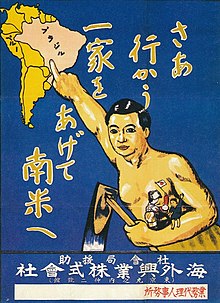
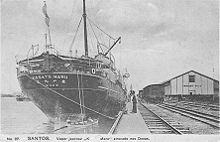
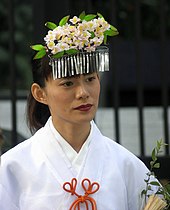





















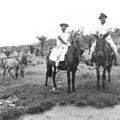
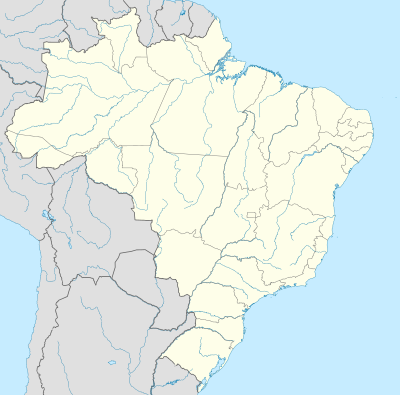
No comments:
Post a Comment